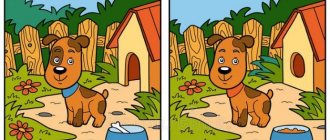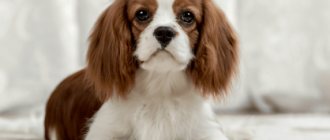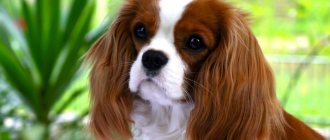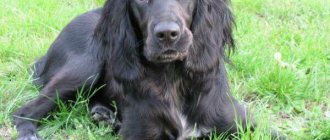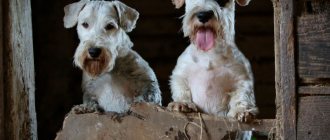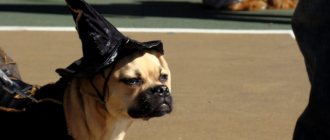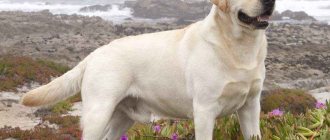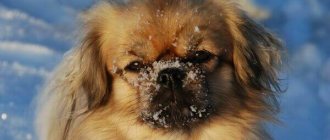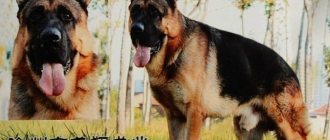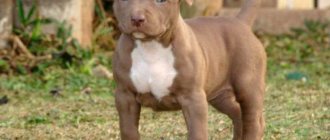Main characteristics
| Breed parameters | |
| Country of origin: | Great Britain |
| Weight of the breed: | 5.5-8 kg |
| Height at withers: | 30.5-33 cm |
| Temperament: | active |
| Wool: | long |
| Role in human life: | companion |
| Breed group: | decorative |
Thanks to its long coat of unique colors and expressive exterior, the dog can become a real decoration. But it is not only decorative. Some representatives are trained for hunting, so in pursuit of prey they show high hunting qualities. Caring for an animal is not difficult, raising it is also not difficult: the dog has nobility and dignity in its character, passed down from its ancestors - regulars at British aristocratic lodges.
History of color formation
The ancestors of modern Cavalier King Charles Spaniels are the King Charles Spaniels. The breeds differ among themselves in the structure of the skull and coat color. In the past, these animals were extremely popular at the court of the Queen of England. Having previously been representatives of the hunting class, spaniels gradually reclassified into the category of decorative dogs.
Charles II showed particular interest in Charles Spaniels. Knowing this, the court dog handlers tried to please their ruler. Why they worked tirelessly to develop new and unusual colors. By adding genes from other breeds, they were able to produce black and tan puppies. However, the offspring were not healthy. More than half of the puppies born had genetic malformations. A little later, a three-color color was introduced. It consisted of black, white and red. The two-tone white and chestnut version was given the name "Blenheim".
@cavaliercommunity
Origin
This is a very old breed. The first representatives appeared already in 350 BC. BC: on a coin minted in Macedonia during the reign of Philip II, they found an image of a dog with long ears. Some dog breeders claim that there may be another pet in the engraving, but lovers of this breed trace its history back to this date. Officially, the name appears in medieval historical notes. When describing hunting dogs, the author uses the word “spannel”. This was the name of the long-eared animals that accompanied the participants in the Crusades, which over time fell in love with the British aristocracy and came to England.
The breed, named after the English King Charles II, began its selection with the light hand of this monarch. One day his sister Henrietta d'Orléans showed dogs with amazing eyes and long ears. Charles II liked them so much that he commissioned trained specialists to select the breed, turning its representatives into excellent hunting dogs. The king carefully monitored breeding and actively took animals with him on hunts.
Extremely fascinated by the breed, Charles II issued a decree: its representatives can appear in any public place, including the English Parliament. During the 18th century, dogs became increasingly popular. At this time they began to be called King Charles Spaniels.
Apart from Charles II, dogs were very fond of the British aristocracy, including different generations of monarchs and dukes. Famous artists preferred to paint pictures with spaniels. But in the middle of the 19th century, miniature decorative dogs became fashionable: Japanese Chin, Pekingese. To get the same short muzzle and perky nose, breeders crossed the Charles II Spaniel with these breeds. The dog acquired a round skull, wide-set eyes, and a steep forehead. Of course, the hunter's performance characteristics were forgotten, and now spaniels reclined in the salons of eminent ladies on pillows, receiving the nickname “toy” - that is, “toy”.
Price
In Russia, the breed has not yet reached the peak of popularity. But, despite this, Cavalier King Charles Spaniel kennels are available in several large cities, including the capitals - geographical and Northern. Therefore, there should be no misunderstandings when searching for a dog.
But before you buy a dog of this breed, you should ask yourself the question - why? If the goal is not the subsequent breeding of the breed for sale, and the owner does not intend to move the dog from exhibition to exhibition, then you can get by with a pet-class dog, and you will have a pedigree, a passport, and other documents for the animal.
If you also want to save money, then the only option is to buy second-hand. However, there is a lot of information on the Internet about the consequences of such transactions. If the goal is to breed pets and win medals, then a representative of the show class, the elite of the breed, which is genetically endowed with the best characteristics, is suitable.
Such puppies can also be purchased at a nursery. But if the cost for a pet-class dog is about 1000 conventional units, then the price of a show-class Cavalier King Charles Spaniel will be an order of magnitude, or even several, more.
Description
In general, the Cavalier King Charles Spaniel is graceful and elegant. His black nose has clearly defined nostrils; the muzzle has a wedge shape; lips don't sag. This type of spaniel has strong jaws. A characteristic feature is large eyes: they are always dark in color, round, but not bulging. The Cavalier King Charles is also distinguished by long ears: they are set high, with long hair. If previously the tail was docked, now the standard requires that its length and the length of the body look balanced.
The Cavalier King Charles Spaniel moves with free elegance. The push is produced by the hind limbs; He is a confident and strong dog. The pets have long hair, their coat is straight and silky, but some waviness is allowed. The Cavalier King Charles Spaniel does not need to be trimmed. The key characteristic of his exterior, as well as his character, is harmony. It is this kind of pet that wins recognition at exhibitions; The exterior is similar to the Jack Russell Terrier.
The coat color of the Cavalier King Charles Spaniel has the following options:
- Black and tan.
- Bright red.
- Blenheim is a mixture of white base color and chestnut spots with clear contours.
- Tricolor: a combination of white and black colors; tan marks above the eyes, near the tail, inside the ears, on the cheekbones, on the inside of the limbs.
Particularly valuable is an adult dog that has a pronounced diamond-shaped mark on its head. When a spaniel has a color variant other than those indicated, this is considered a fault.
Home → Useful tips → Good to know → Color genetics Cavalier King Charles Spaniel
Color Genetics Cavalier King Charles Spaniel
According to the FCI standard, the Cavalier King Charles Spaniel breed has 4 colors. These are Blenheim and Tricolor (spotted), Black and Tan and Ruby (solid). All four colors have their own description in the standard:
The following colors are acceptable:
- Black and Tan: Black with tan markings above the eyes, on the cheekbones, inside the ears, on the chest, legs and under the tail. The tan should be bright. White markings are undesirable.
- Ruby: Solid bright red color. White markings are undesirable.
- Blenheim: Bright, well-defined chestnut spots on a pearly white background. The markings on the head are evenly divided, leaving room for the prized diamond marking (a unique feature of the breed).
- Tricolor: Black and white, with clear edges; with sun spots above the eyes, on the cheekbones, on the inside of the ears, on the inside of the legs, and under the tail.
All other colors in the coat are not acceptable.
It should be noted that for cavaliers of solid colors the standard states that white markings are undesirable. But it all depends on the degree to which these marks appear. A slight deviation in the form of a small white mark is allowed on the chest and throat. But spots on the limbs, muzzle, and forehead are considered a fault. The presence of a white spot on the chest of a black and tan or ruby indicates that the dog has the spotting gene, which means it can be bred not only with a solid color, but also with Blenheims and tricolors. With this mating, the dog will produce spotted and solid-colored puppies.
To make this table more clear, let's give an example.
When mating dogs of solid color (the parents do not have spotted dogs in their ancestors or in the pedigree
there is only one):
- ruby + ruby = there will be only ruby.
- ruby + black and tan = ruby, black and tan.
- black and tan + black and tan = black and tan, ruby.
You will never get Blenheim and Tricolor dogs in these combinations. But it is possible that white markings will appear in puppies.
When breeding dogs of solid color, in which both parents have spotted ancestors in their pedigrees:
- ruby + ruby = ruby,blenheim
- ruby + black and tan = ruby, black and tan, tricolor Blenheim (all 4 colors possible)
- black and tan + black and tan = black and tan, ruby, tricolor, blenheim (all 4 colors possible)
When breeding spotted dogs, the puppies will only be spotted. And from two spotted dogs, accordingly, you will never get puppies of a solid color.
Often white spots on the throat will go away as the dog ages, but those on the chest may not go away. The puppy develops, and the chest becomes overgrown with decorative fur, covering the spot. In the ring, a dog with a small white spot may have better structure and movement, etc. compared to an unspotted dog that is not built as well or looks worse when moving. In this case, the dog with the white spot should be placed in front and even win if all its other parameters are good. This opinion is shared by foreign experts and breeders. But in the ring, if both solid colored dogs look the same, the judge will still prefer the dog that does not have white spots.
Dogs that have very large fused spots on the body, so-called "coat patches", should not be penalized as a fault, nor should any dog with a heavily whitened body. Both options are acceptable, but need to be considered in relation to other dogs in the ring with more demarcated spots, as required by the standard.
Photo of Cavalier King Charles Spaniel
The dimensions of an adult dog are as follows: height at the withers is a maximum of 33 cm. How much does the pet weigh: 5.5–8 kg. In terms of height and weight, the main thing is that the dog looks balanced.
Difference between Cavalier King Charles and King Charles Spaniel
It is worth noting that King Charles Spaniels and Cavalier King Charles Spaniels have common historical roots, and until recently they were considered dogs of the same color. But modern standards distinguish them into two different subspecies, which differ from each other in the following indicators:
- Cavaliers have a longer nose than King Charleses. In the latter type they are more snub-nosed.
- Cavaliers have a flat skull, while Kings have a dome-shaped skull.
- The former have a scissor bite, the latter have an overshot bite.
- Cavaliers are much larger than King Charles.
Cavalier King Charles Spaniels are loyal friends. They will brighten up the lives of older people and bring joy and laughter to families with children. But it is worth remembering that dogs require full dedication and attention in return.
Character
The key feature of the animal is the ability to adapt to the owner - his mood, habits, etc. Therefore, it is recommended that busy, elderly people get one. The pet is friendly, graceful, cheerful and sociable. His character is completely devoid of aggression or malice; he will never bite the owner or members of his family.
The dog is great for a large family with small children. On occasion, it can even protect the baby. He loves to frolic, run, jump, and participate in active games. There is something aristocratic in his appearance: he is always obedient to his owner, in public or outside he behaves with dignity. The pet's friendliness and calmness are manifested in its attitude towards other animals.
The spaniel does not need one “leader”, a leader, a person to whom he will obey. He loves all the members of the family in which he lives, does not single anyone out, and behaves evenly and harmoniously. Cavalier King Charles is clean, he will not go into the dirt, following a genetic habit inherited, probably, from the royal palaces.
The advantage of a pet for keeping in a city apartment is its rare barking - it does not speak often, which does not irritate either household members or neighbors.
These pets need activity and attention - without these things they withdraw into themselves. They are completely unsuitable for protection, because there is no malice in their character, they do not know how to quarrel. But with proper training, they show excellent hunting qualities and can chase birds and small rodents. After weighing the pros and cons, you should choose this dog: its childishly expressive eyes, playful demeanor, devotion and helpfulness will delight anyone.
Nutrition
Proper nutrition will ensure that your dog’s “calling card”—its coat—looks decent. It will shine and flow like silk, and your teeth will be strong and healthy. It would seem that everyone knows this rule. But in reality it is not always possible to follow the principles.
Once the Cavalier King Charles Spaniel puppies leave the kennel and cross the threshold of their future home, the owners become fully responsible for their pets.
A real salvation at first can be instruction from the nursery staff, which describes the daily routine, feeding regimen, weight of portions and their composition. If the dog was raised on factory products, then the breeder can, as a bonus, provide the future “resettler” with food for the journey and for the first time.
If there is no such instruction from breeders, then it is worth taking as a basis the golden rules of feeding almost any breed: up to three months, 5-6 meals a day, up to six months, three meals a day.
After this, you can transfer the dog to feeding twice a day. The Cavalier King Charles's diet can be provided either from natural products, or from factory feed, or mixed.
The “red list” of forbidden delicacies is standard: nothing salty, sweet, fried; no baked goods or sausages of any kind. River fish is prohibited, and sea fish must be served boiled. Bones, potatoes, pasta, legumes and two cereals - pearl barley and semolina - are prohibited.
The temperature at which food is served to the dog should be around 30 degrees. Hot food is prohibited. At the same time, it is worth providing the dog with constant access to a bowl of clean water. In summer, this needs to be monitored especially strictly.
Care
Since pets have long hair, they need to be brushed every day. During the molting period - autumn and spring - combing is carried out even more often. The ease of caring for the Cavalier King Charles Spaniel's coat is that there is no need to trim the dog. It is enough to bathe it with special products so that the cover looks shiny, as in the photo.
Hanging ears of decent length often accumulate wax and dirt. As they become dirty, these organs are cleansed with cotton wool. Do not penetrate too deeply into the animal's ear so as not to touch the cartilage.
During the warm season, it is necessary to regularly check whether ticks have settled in the animal’s ears - especially after a forest walk or a long stay in nature. If a tick is found, it is quickly removed using tweezers, cotton wool, and the area is wiped with a disinfectant.
It is useful to wipe the spaniel's eyes with a soft cloth soaked in a weak chamomile or tea infusion - this can prevent souring. The pet’s teeth are brushed 1–2 times a week; Nails are trimmed once or twice a month. After a walk, especially in winter, it is necessary to wipe the animal’s paws and lubricate them with some oil.
Breed standard
The Cavalier King Charles Spaniel in the photo looks smaller than in life: its height is up to 34 cm, and the dog weighs from 5 to 8 kilograms. The dog gives the impression of being active and graceful. It has an almost flat skull between the ears, and the muzzle visually resembles a triangle. The nose is black and should be well developed.
Cavalier King Charles Spaniel age 3.5 years
This breed has beautiful, wide-set, large, round and dark eyes, as well as long ears that are set high. The strong jaws have a regular scissor bite. The dog has compact paws with developed pads. The tail is quite high.
The fur coat of gentlemen is long, thick and silky. Its texture is straight, but sometimes waves are acceptable. Acceptable colors are black and tan, anthracite with red eyebrows, cheeks, chest, paws and the area under the tail.
The red color should be bright, and the presence of white spots is highly undesirable. Two more colors recognized as the standard are ruby and bright chestnut monochrome. A variation of triple colors is possible, where black, white and red colors appear.
Feeding
The Cavalier King Charles Spaniel eats natural or store-bought food. The basis of the dog’s diet is fresh meat of any kind, but not pork: chicken, beef or veal. Among other products we highlight:
- Buckwheat porridge.
- Low-fat cottage cheese.
- Rice.
- Boiled vegetables in small quantities.
- Fruits, best seasonal.
Next to the food bowl there should be clean boiled water, which is changed for the animal once a day. To keep your dog in great shape, vitamins and minerals are included in its diet.
Puppy price
It will be useful to know how much a Cavalier King Charles Spaniel puppy costs. The cost of the kutenka will be influenced by several main factors:
- color;
- availability and quality of pedigree;
- class (pet, show).
Pet class is usually sold without documents, but with the ability to obtain them at the expense of the owners. Puppies of the most common color, Blenheim, will cost less - about 20,000 rubles, and with documents from a good nursery, 5-10 thousand more. The rarest, tricolor puppy - about 40-50 thousand. Show-class cuties with a first-class pedigree can cost future owners 50 thousand rubles and more, this price will be determined by the rare qualities of the dog (the presence of the blood of ancestors from the most ancient nurseries in Europe, the opportunity to participate in breeding and exhibitions, etc.).
Vaccination
In the nursery, a Cavalier King Charles Spaniel puppy at 8 months receives its first vaccinations against:
- Parainfluenza.
- Salmonella.
- Leptospirosis.
- Hepatitis A.
- Plagues.
Vaccination against the listed diseases is repeated at 12 weeks, 6 months, 1 year. It is repeated annually.
The dog receives an anti-rabies injection at 7 months, then every year.
Choosing a puppy by character
Cavalier King Charles Spaniel puppies are not divided by gender in character; their traits do not depend on this. Both males and females are gentle and affectionate towards their owners, active and inquisitive, loyal and love children. The choice in this case will depend on the personal qualities that the owner wants to see for himself.
If you need a calmer dog, then from a flock of playing kids you should choose one who will be distracted from his activity to explore a new object for him. This will be a creative dog who will prefer leisurely exploration of the surrounding space to activity.
If you want your puppy to get along with other pets in the family, then it’s worth observing whether the kitten is inferior to other animals in games. There are dogs that are leaders in character, they will try to the last to take the toy, and there are omegas in the pack who will kindly give it away, without losing anything, but will maintain a friendly atmosphere.
Photos of Cavalier King Charles Spaniel puppies
A healthy puppy's characteristics correspond to the standard: he is active, cheerful, and looks healthy. The price ratio is:
| Price difference | |
| No pedigree | 45,000 rub. |
| From champion parents | 70,000–80,000 rub. |
How to choose a puppy
When choosing a Cavalier King Charles Spaniel puppy, you can follow the general rules for purebred individuals:
- You should not choose a pet from nurseries that are completely unsanitary and disorderly;
- You should definitely ask professional breeders not only for documents for the animal, but also for test results for genetic diseases;
- The temperament of gentlemen is not related to gender and coloring, since representatives of both sexes are affectionate and devoted to the owner, so the choice of a pet is made only based on one’s own preferences.
Before you get a healthy puppy, you need to get acquainted with the pedigree of its parents. You should not purchase a gentleman born from closely related individuals. You need to pay attention to the most inquisitive and active baby who will show a keen interest in a toy or a fallen bunch of keys. If the puppy is lethargic and indecisive, he may be physically and mentally exhausted. The price depends on the state of health, age, whether the parents have medals and a number of other factors; it starts from 45,000 to 85,000 Russian rubles.
The Cavalier is ideal for people who lead an active lifestyle and have enough time to take care of their pet. This is a magnificent animal that is suitable for both a single person and a large family.
Colors of Cavalier King Charles Spaniels (tricolor, bicolor, monochrome)
Each color of the Cavalier King Charles Spaniel has an official name. Cavaliers have four types of colors (two bicolors, tricolor and monochrome).
The two-colored Cavalier King Charles Spaniels are as follows:
Blenheim or Chestnut White: Symmetrically arranged patches of rich chestnut color on a pearly white background, with one of them located on the crown between the ears.
Black and Tan: Rich black with tan around the eyes, cheeks, inside of the ears, chest, paws and inside of the tail.
Monochrome Cavalier King Charles Spaniels looks like this.
Ruby (rarest): deep red with mahogany undertones; white markings are not allowed.
Below are photos of Cavalier King Charles spaniels of tricolor color.
Tricolor, or black and white with tan: black spots and bright tan marks are symmetrically located on a pearl-white background; the ears are black, there are small black spots on the face, black glasses around the eyes.
Below watch a video about the Cavalier King Charles Spaniel dog breed:
Description of Cavalier King Charles Spaniels (height and weight)
Below are photos and videos of Cavalier King Charles Spaniels - both adults and their puppies.
The height of dogs at the withers: 30.5-33 cm.
Weight of Cavalier King Charles Spaniels: 6-8.2 kg.
Average life expectancy: 9-10 years.
Other names: King Charles II Spaniel.
The description of Cavalier King Charles Spaniels is similar to the description of classic spaniels - they are extremely friendly, affectionate and energetic dogs, very sociable and welcoming. Her ability to get along well with dogs of other breeds and other pets makes her an ideal family pet. The breed is good for representatives of all ages: from children to the elderly. Cavalier King Charles Spaniels dogs love to snuggle comfortably on their owner’s lap and delight him with their presence. At the same time, these small dogs love to attract attention with various tricks and pranks. When parenting, you should show both gentleness and persistence.
Description and breed standard
Height at withers: 30-33 cm; Weight: 5.4-8 kg.
- Colors: black and tan, blenheim, ruby, tricolor.
- Eye color: dark (brown).
- Nose color: black.
- General appearance: A small dog with a silky coat, long ears and a wedge-shaped muzzle.
Disqualifying signs in this breed are any serious deviations from the standard. The degree of non-compliance is assessed by a qualified expert.
The Cavalier King Charles Spaniel has a close relative - the King Charles Spaniel . The first ones differ in the following characteristics:
- Long muzzle;
- Scissor bite;
- High set ears;
- Flat skull;
- Greater height and weight;
- Calm character.
These two breeds have completely different facial expressions and looks.
What is the color and color of Cavalier King Charles Spaniel dogs?
The visible pigment of the outer part of the hair. A significant number of dogs, along with pigmented hair, have white spots or marks in certain areas of the body that are devoid of pigment, i.e. hair lacking pigment. When mixing colors, the color of the dog is determined by the dominant color. A dog has such types of hair as downy, integumentary (smooth), guard hair. The different properties of wool are determined as an adaptation to different climatic conditions and their habitat. Each type of coat and its color requires special care. Breeders have studied how color and patterns are created on the body of an animal. Genes can be responsible for hair structure and color. This is general information that applies to all dog breeds and does not apply to Cavalier King Charles Spaniel puppies.
- A. With the help of this locus, a solid color of the pet’s entire body is obtained (monochromatic).
- B. Dyes wool black. Some species have partial of this gene (spotting). Some dog breeds necessarily have this gene!
- C. This is the key component! With its help, the body produces color throughout the body. If this component is missing, the dog may be born without color (albino). The color of the nose and iris does not depend on this component.
- D. If there is little gene in the pet’s body, then the coat will be lighter. If there is a lot of gene in the body, then the dog will have a rich black color. The gene affects the viability of the dog; if a pet is born with a lack of the gene and a blue color, then he may most likely not live to see his senior years. When the gene is dominant, the color of the pet turns out to be black.
- G. With old age, this component is activated and gray hair appears. They call him gray-haired. When the color turns gray.
- E. With its help, in most cases, three-color colors are obtained, containing pigment of black, brown and yellow.
- M. The gene leads to anomalies for the pet and gives a harlequin pattern. Has a marble color. With old age, the gene can lead to lightening of color.
- S. This gene causes partial body pigmentation in dogs. (white spotting).
- T. The gene is characterized by mottling. It is opposite to the S gene and forms dark spots on white areas.
- R. Chastity - alternation of hair that is colored and not.
